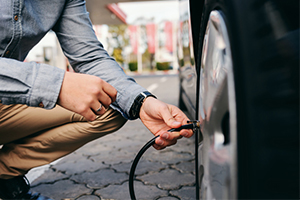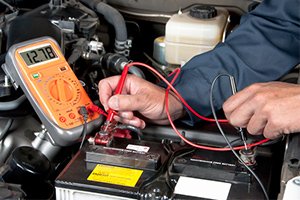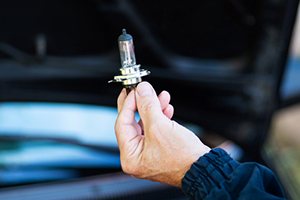Winter-proofing your car is pivotal if you care about prolonging your vehicle’s health and saving money. The long days of summer are behind us and the days are shorter as winter approaches, so plan ahead and be ready when temperatures plummet. Use this winter maintenance checklist to perform these simple and affordable checkups now and possibly save hundreds or thousands of dollars down the road. Most importantly, help ensure your safety and the safety of others when driving in rough weather.
? Maintain Proper Tire Pressure

Ensuring your tires are properly inflated is the most critical maintenance check for extending your tires’ life. According to Goodyear, your tire pressure decreases about 1 PSI for every 10°F drop in temperature. Using a proper tire gauge, check your pressure and fill them up based on your car’s recommended PSI. Not having enough air in your tires may decrease your gas mileage and wear out your tires faster.
? Check Your Tire Tread
Don’t just stop at your tire pressure. Check your tire tread, too, and assure they’re not worn out. Driving with bald tires is extremely dangerous since it does not maintain a good grip on the road. With the cold and wet winter months approaching, that could bring several scary possibilities from skidding, sliding, or hydroplaning. To check if you need to replace your tires, try the penny test. Additionally, if it snows where you live, consider getting a set of winter tires for better control and more traction while driving.
? Flush and Refill Cooling System with Antifreeze
Antifreeze is a critical fluid in your car’s cooling system that keeps your engine from freezing during the winter months. Over time, your antifreeze breaks down and loses its ability to protect your engine against corrosion and dramatic temperature changes. To prevent this, Advance Auto Parts suggests performing a proper flush to your coolant system and add a 50/50 mixture of antifreeze and water into the appropriate reservoir.
? Inspect Your Battery

As the temperature drops, your battery requires a lot more energy to keep the car running. With care, it is possible to preserve your car battery’s life and reduce the chance of being stranded on the side of the road. Start by cleaning any corrosion on top before moving onto your cables next. Then, inspect your battery for any leaks and test its charge with a multimeter. A voltage of 12.45 or lower is a sign that you need to recharge it.
? Replace Old Windshield Wipers
Windshield wipers and washer fluid are crucial parts of a safe driving experience, especially in the cold. It protects you from outside elements and helps your visibility on the road. Make it a habit to replace your wipers every year as gunk and grime build-up on the blades that could damage your windshield. Besides, you don’t want to hear that squeaky wiper sound every time you use it, right?
? Refill Windshield Washer Fluid
Are you still driving around with bug wash from last summer in your tank? It’s time to switch it out with a winter washer formula. These winter washer fluids contain methanol or ethylene glycol designed to handle freezing temperatures. The last thing you want is your regular washer fluid freezing up and damaging your pumps or reservoir. It also helps with preventing ice on your windshield too.
? Inspect All Lights and Bulbs

Do you live in a place that has daylight savings? If you do, then you know it gets darker earlier towards the end of the year. Take a moment to check all headlights, taillights, brake lights, turn signals, hazard lights, and back-up lights. Replace any burnt out or cracked bulbs immediately. This small maintenance check helps you see in the dark, and it may also help you avoid a hefty fine and point on your driving record for driving at night without headlights on.
? Keep Your Gas Tank Full
It’s not a bad idea to keep your gas tank full throughout the year because who likes to be stranded along the highway? Your car and wallet will thank you for taking this extra precaution of keeping a full tank. Having a depleted tank may cause moisture to build up inside. This can lead your fuel to dilute and/or strain to your pumps and fuel lines.
? Carry an Emergency Kit with Winter Supplies
Keeping an emergency kit with winter supplies is the most important thing you can do for your safety. You certainly don’t want to be stranded in a winter storm waiting for help with no supplies.
- Reinspect your emergency kit and include some winter items in case something goes wrong while traveling.
- Include a few blankets, gloves, boots, and extra clothes to keep warm.
- As for tools, pack jumper cables, road flares, flashlight with extra batteries, ice scraper, tire chains, a small shovel, and a bag of sand or kitty litter.
- Remember to put a few high-energy snacks like jerky or trail mix in your glove box, as well.
? Add Roadside Assistance Coverage

Being stranded with car issues is never a pleasant experience. Luckily, most insurance companies offer Roadside Assistance coverage that you can add to your Auto Insurance policy. The best part? It’s affordable and may protect you from a wide range of mishaps from lockouts, dead battery, flat tires, fuel delivery, and towing. Speak with an Insurance Specialist today by calling (855) 919-4247 to get a free quote and learn more about the benefits of Roadside Assistance coverage.
The information in this article is obtained from various sources and offered for educational purposes only. Furthermore, it should not replace the advice of a qualified professional. The definitions, terms, and coverage in a given policy may be different than those suggested here. No warranty or appropriateness for a specific purpose is expressed or implied.
